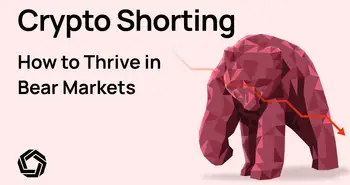A crypto trading strategy to help you survive this bear market

The stock market is down by over 20 percent and Bitcoin is down over 70 percent, so we can confidently say we’re in a bear market. In case you haven’t heard the term before, a bear market happens when the stock market declines 20 percent or more.
Bear markets raise uncertainty about the future and increase market volatility. As a result, investors often don’t know which actions to take and their portfolios end up sustaining long-term losses.
And while it is true that bear markets are usually followed by bull markets (when market prices go up), plenty of portfolios take a lot longer than the markets to recover, while some never do.
Short selling (sometimes called going short or just shorting) is a strategy traders can adopt during those periods, because it leads them to profit as the market goes down. However, while shorting can be extremely exciting and profitable, it can also be a risky strategy if not done right because it can lead to – at least in theory – to infinite losses. By the end of this article, you will know what short selling is, how it works and the best ways to do it.
What exactly is short selling, anyway?
You should short an asset when you expect it to decrease in value, and go long when you expect it to increase in value.
On most exchanges, to open a short position you have to borrow some cryptocurrency and then sell it at the current price. Then, you have to buy that same digital currency back at a later date and repay the capital you borrowed. If the price of that coin drops by the time you buy it back, you will make a profit on the difference between the cost of buying and selling.
Here is an example:
- You want to short one Bitcoin when the market value of Bitcoin is $50,000. So you borrow one Bitcoin and sell it at market value, earning $50,000.
- The price of one Bitcoin then drops to $35,000.
- You buy one Bitcoin for $35,000 and return it to the broker you borrowed it from plus interest.
- You keep the difference between the sale and purchase price, meaning $50,000 – $35,000 = $15,000 (minus any interest).
This example illustrates very clearly how shorting usually works, but it’s just as important to know that there are several reasons to short sell crypto.
The risks of shorting
Potential for unlimited losses
A huge problem with short selling is its potential for unlimited losses. When you buy an asset (go long), you can never lose more than what you initially invested. Since there is no limit to how high the price of any crypto can go, your potential gain is, at least in theory, infinite.
However, if you short crypto at $50, the most you can make on that transaction is $50 (if you are not trading on margin). But here is the catch: if that crypto goes up to $100, you’ll have to pay $100 to close your position. The same is true if the price goes up to $1000. In other words, there's no limit on how much money you could lose on a short sale.
Margin interest: borrowing to sell
Trading on margin allows you to leverage the funds in your account to borrow more funds and increase your buying power. In other words, it means you borrow money to trade with more than what you have.
When you trade on margin, you increase the odds of having a higher reward by taking on extra risk. Because you are borrowing money, you owe it back along with any applicable fees, no matter what. To make sure they receive the loaned amount back, exchanges will usually liquidate your margin trade once it hits a price where you would start losing the borrowed funds. But depending on which exchange you are using, if your trade goes south you may end up actually losing the owed funds and then some.
Short squeezes
As a short seller, you borrow crypto that you believe will drop in price and sell it now, in order to buy them after they fall. If you are right, you return the crypto and pocket the difference in price between when you initiated the short and when you close the position. But if you are wrong and the price goes up, you are forced to buy that asset back at a higher price, leading to loss.
If the price of an asset you shorted rises fast, you need to act quickly and close the position to limit your losses. Now imagine a lot of people are shorting a market at the same time as you, and as you decide to buy the asset back to cut their losses, so do they. As a result, the price is pushed even higher, attracting even more buyers that push the price further up. A short squeeze is a combination of new buyers and panicked short sellers that creates a rapid rise in price that can lead short sellers to have massive losses.
Common Shorting Strategies
Before you use any method to short sell crypto, you have to identify a downtrend. Since the market is highly volatile, many factors can send it in one direction or another. For example, politics, hype culture, and even tweets from influencers can disrupt the crypto market.
Make sure you study the news and sentiment around any currency you plan to short. After that, you have to open your margin trading account. Most crypto brokers allow you to short sell.
Now that you know more about short selling crypto, let’s cover the five different ways you can short it.
Direct Short Selling
This is the first method you will usually come across when researching short selling. Simply put, direct short selling is when you borrow crypto from an exchange at a specific price and sell it.
Then you wait for the price of that crypto to go down. When it does, you buy it back and return the borrowed coins to your exchange. This way you profit from the difference in prices.
Futures Markets
Like many other assets, some cryptocurrencies have futures markets. A futures contract obligates parties to transact a certain asset, at a predetermined price, at a predetermined time in the future.
Futures come with a long and a short side of the contract. While one party agrees to deliver at a future date, the other agrees to accept the delivery. The long contract benefits if the price of the market goes up, and the short side benefits if the price goes down. There is always an equal number of long and short contracts in the markets (that number is called open interest).
Contracts for Difference
This is one of the most popular ways of shorting crypto. With contracts for difference, your broker allows you to bet on the change in an asset’s price without having to actually own it. You can bet on the price going up or down.
All you have to do is deposit the necessary funds to guarantee that you’ll be able to buy the crypto at the particular price you’re betting on. While the deposit stays in your possession, the exchange or broker gets to hold it as collateral.
As a result, you only need to give away a small part of the total trade amount to open your position. This amplifies your return if the market moves in the direction you expect, but it also amplifies your losses if the market goes against you. This method is extremely risky if your prediction is wrong.
Crypto Put Options
Put options are the riskiest of all the strategies listed here. A put option gives you the right, but not the obligation, to sell a cryptocurrency at a predefined price on a set date in the future. However, if you are in the US, you can also exercise the put option before the expiration date. The extra layer of risk here comes from the fact that not only does the price of the crypto asset you are shorting fluctuate, but so does the price of the put option contract itself. In fact, the price of the contract fluctuates more than the price of the asset itself.
Imagine you think that Bitcoin’s price will drop next year. With put options you can buy a Bitcoin put for six months with a strike price of $40,000. This is an oversimplification, but it gives you a general idea of how put options work: if the price of Bitcoin falls below that price on the predetermined date your put will earn you a profit, because you can sell Bitcoin at $40,000 instead of at its lower market price. However, if the price remains high, the option expires worthless, and all you lose whatever you paid for purchasing that option.
Prediction Markets
Prediction markets are similar to mainstream conventional markets. As an investor, you may expect the price of a cryptocurrency to decrease by a particular percentage. On a prediction market, someone else can take you up on that bet. If the price really does go the way you predicted, you earn a profit. Popular prediction markets include Polymarket and Augur.
Virtual Futures
Virtual futures are a novel way to short cryptocurrencies. They were introduced by Morpher, a trading app that uses a set of Ethereum smart contracts that observe the price of all kinds of exchange-traded assets globally and in real time. The Morpher protocol uses that data to replicate the economics of holding that asset on the blockchain. Via its native token (MPH) bets can be made on any of the markets that the protocol supports, like Bitcoin, Apple, or Gold. Instead of trading by buying from or selling to another person, you interact with a smart contract on Morpher.
That makes shorting extremely easy. Trades happen immediately and there are no commissions. If your position earns a profit, the smart contract mints a proportional amount of tokens. If you realise a loss, the contract destroys a proportional amount of staked tokens. So a short position of 100 MPH Apple stock becomes 110 MPH, if the price of Bitcoin decreases 10 percent, or 90, if the price goes up 10 percent.
Behaviors to help you succeed
Follow the Market Trend
A bear market is a great opportunity to short sell, because that means you’re following the market’s general downtrend. You should refrain from shorting during a bull run when the market trend is to go up. That increases your chances of losing.
Don’t be too greedy
Short selling is risky. It needs careful analysis and timing. It also only works during certain trends and doesn’t last for longer periods. When attempting a short sale, it’s important not to make emotional decisions and to have a thorough plan.
Remember the old Wall Street saying: “Bulls make money. Bears make money. But pigs get slaughtered.” Short selling does not always guarantee profit.
The best place to get started
As you have seen in this article, short selling can be somewhat complicated. If you are a beginner, virtual futures are by far the easiest and safest way for you to start shorting. Virtual futures allow you to trade with a smart contract as your counterparty, and you don’t need to borrow funds from another party or pay interest to short a market.
To start shorting via virtual futures on Morpher, all you need to do is take a look at the 700 assets we have available on the platform and then decide which ones you believe are going down.

Disclaimer: All investments involve risk, and the past performance of a security, industry, sector, market, financial product, trading strategy, or individual’s trading does not guarantee future results or returns. Investors are fully responsible for any investment decisions they make. Such decisions should be based solely on an evaluation of their financial circumstances, investment objectives, risk tolerance, and liquidity needs. This post does not constitute investment advice.

Painless trading for everyone
Hundreds of markets all in one place - Apple, Bitcoin, Gold, Watches, NFTs, Sneakers and so much more.

Painless trading for everyone
Hundreds of markets all in one place - Apple, Bitcoin, Gold, Watches, NFTs, Sneakers and so much more.









